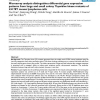Free Online Productivity Tools
i2Speak
i2Symbol
i2OCR
iTex2Img
iWeb2Print
iWeb2Shot
i2Type
iPdf2Split
iPdf2Merge
i2Bopomofo
i2Arabic
i2Style
i2Image
i2PDF
iLatex2Rtf
Sci2ools
BMCBI
2006
2006
Microarray analysis distinguishes differential gene expression patterns from large and small colony Thymidine kinase mutants of
Background: The Thymidine kinase (Tk) mutants generated from the widely used L5178Y mouse lymphoma assay fall into two categories, small colony and large colony. Cells from the large colonies grow at a normal rate while cells from the small colonies grow slower than normal. The relative proportion of large and small colonies after mutagen treatment is associated with a mutagen's ability to induce point mutations and/or chromosomal mutations. The molecular distinction between large and small colony mutants, however, is not clear. Results: To gain insights into the underlying mechanisms responsible for the mutant colony phenotype, microarray gene expression analysis was carried out on 4 small and 4 large colony Tk mutant samples. NCTR-fabricated longoligonucleotide microarrays of 20,000 mouse genes were used in a two-color reference design experiment. The data were analyzed within ArrayTrack software that was developed at the NCTR. Principal component analysis and hierarchical clus...
BMCBI 2006 | Colony | Large | Small Colony |
| Added | 10 Dec 2010 |
| Updated | 10 Dec 2010 |
| Type | Journal |
| Year | 2006 |
| Where | BMCBI |
| Authors | Tao Han, Jianyong Wang, Weida Tong, Martha M. Moore, James C. Fuscoe, Tao Chen |
Comments (0)

